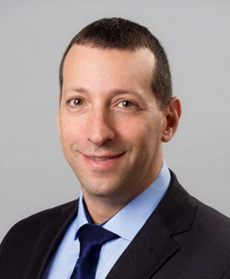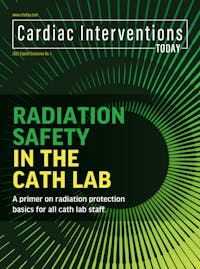Advertisement
Advertisement
2023 Digital Exclusive No. 1
Sponsored by Radiaction Medical
The Radiaction Experience: Bringing Groundbreaking Radiation Protection Technology From Concept to Market
Amir Belson, MD, Founder, and Jonathan Yifat, CEO, share insights into the Radiaction radiation protection system’s development, function, and utility.
When scientists began investigating ionizing radiation in the late 1800s, they learned two things quickly: x-rays have a powerful ability to penetrate soft tissue to image structures deep within the body, and overexposure can lead to injury, illness, and in some cases, death. Since then, the challenge has been to optimize the use of this incredible technology during invasive procedures while providing protective measures to those who are utilizing it.
Over time, radiation exposure has led to increasing concerns of cancer, dementia, musculoskeletal pain, cataracts, fetal exposure, and other ailments. Consequently, many caregivers find themselves questioning whether the rewards of a career in interventional procedures is worth the risk to their own health. There are many ways to block scatter radiation in order to protect treating physicians and staff, but current means have left room for improvement and opportunities for innovation.
This was the situation that confronted Israeli pediatric nephrologist, medical device inventor, and entrepreneur Dr. Amir Belson and spurred him to imagine a different approach to radiation protection—enhancing the barrier of protection from solely being on the treating staff to also being directly on the imaging device itself—providing a proactive solution that allows for full procedural workflow efficiency and immediate patient access. To bring his vision to reality, Dr. Belson started Radiaction Medical and chose medical physicist Jonathan Yifat to guide the project to completion as Radiaction’s CEO.
A year after their milestone FDA clearance for use in the United States, Dr. Belson and Mr. Yifat describe their journey.
What initially led you conceptualize the Radiaction System (Radiaction Medical) and ultimately found the company to develop it?
Dr. Belson: I noticed a cardiologist friend of mine limping due to back surgery after years of wearing a heavy lead apron during fluoroscopic procedures. It weighed 20 pounds and was often worn for long periods, but he never really thought about it until his back pain became excruciating. On top of that, there are areas of the body that remain exposed while wearing lead, notably, the arms, head, and neck. I also noticed that when additional shielding is mounted on wheels instead of on the physician, it often impedes free movement and patient access during procedures, and often leaves dangerous gaps in coverage. I began to think that only shielding the physician may not be the ideal solution, and then I thought “what if we shield the fluoroscope?” That’s what initiated the concept, and when I realized that this solution could also drastically reduce overall radiation exposure and protect not only the lead physician, but everyone in the room, from head to toe, I knew we had a winner.
How exactly does the Radiaction System work?
Mr. Yifat: Beyond the obvious utility of the device, I was immediately attracted to the simple elegance of the idea. It needed a rigorous engineering focus, which led us down the path of incorporating sensor-based technology with highly automated robotic mechanics. The system attaches as an independent accessory to existing C-arm machines on the market (Figure 1). We test and submit for FDA clearance for compatibility with each imaging system design, ensuring that the Radiaction technology does not interfere with C-arm power, functionality, imaging quality, and importantly, does not increase radiation dose to the patient.
As procedural workflow integration is paramount, the system takes about 30 seconds to drape and set up, with 2- to 3-second deployment and retraction of the radiation blocking segments, all controlled by a mechanical panel and button at the bedside (see video). Each segment can be programmed independently to stay up or deploy, allowing customizable programming depending on the procedure, physician preference, or access requirements. The proximity sensors built into our system detect the bed, as well as patient size, and will stop automatically for a customized fit based on size and location of the patient.
All of this ensures ideal and immediate access to the patient, regardless of the type of procedure being performed. Once the segments are deployed, the system contains the scatter radiation coming from the imaging beam itself, therefore blocking radiation at the source and providing protection to the entire procedure room staff.
What was the journey from concept to creation of this technology?
Mr. Yifat: Before Radiaction, there was no comprehensive solution to proactively protect the entire interventional team from head to toe. I knew Dr. Belson’s concept had the potential to be that solution, and I remember thinking it would be a piece of cake. Of course, I laugh about that now. This project was simple only in concept, and making it real required a sustained effort by a lot of talented and innovative people. When we shifted out of the development lab and moved into real clinical settings at our first site, we started learning how to truly accommodate procedural workflow. We quickly learned the speed at which cardiologists need to work, and that it’s not enough to have a device that protects only them. It needs to be unobtrusive and extremely easy to operate, never impeding their ability to perform lifesaving interventions. Anything less would be quickly discarded. This led us to start with a few development leads, and a mechanical prototype that evolved into a robust high-tech device with a mature company supporting it. Like working on a complex puzzle, bit by bit, over time it took shape. With our recent FDA clearances, we now can provide this technology that could protect the health and lives of untold numbers of health care providers, and that is extremely exciting.
What are the unique advantages of the Radiaction System and the protection it provides?
Dr. Belson: As mentioned previously, it’s not only the lead apron weight that is problematic. Most of these garments only protect the torso and abdomen, leaving the arms, legs, head, and neck exposed. Even the best designs of aprons and shields leave gaps where radiation can enter and cause mutations to genes in the blood cells, and leaded hats won’t stop scatter radiation from reaching the brain because it can enter at the chin and go up through the skull. There’s really no practical way to stop it once it’s in the room. Our competitors’ devices either leave large areas unshielded or involve new versions of unwieldy shields. These devices can also impede immediate access to the patient when needed and only partially protect some of the medical team while leaving others exposed.
The Radiaction System is designed to work within any procedure (eg, percutaneous coronary intervention, ablations, device implantations), and it is the only technology that protects everyone in the room while allowing for immediate patient access, with the potential to significantly reduce the amount of wearable lead during any intervention.
Mr. Yifat: The Radiaction device attaches to the fluoroscope’s C-arm, deploying instantly at the push of a button. It extends dynamic blocking panels to fill the gaps between the emitter and the table and between the image detector and the patient’s body, stopping scatter radiation before it can ricochet around the room. Nothing on the market has this type of automation built into it to block the radiation scatter at the source.
When deployed, the device looks a bit like it’s giving the patient a protective hug; however, it’s really protecting everyone else by providing over 90% reduction in overall scatter radiation, and up to 97% reduction to the operator’s head and neck.1,2 Because the footprint is so small and the user interface so simple and intuitive, the system does not interfere with the usual workflow. Other than a very short operator learning curve, it doesn’t require much effort from the health care staff who already have plenty to think about while caring for patients. Our installation process involves white-glove service during the evaluation period. This ensures that users can operate the device efficiently, all their questions are answered, and any issues are fixed onsite. We make sure the physicians who use our product understand that we have their backs, and that’s key to every successful integration.
What is the biggest obstacle to adoption of the Radiaction System?
Mr. Yifat: Like any medical device, introducing a new product into clinical settings, especially when the stakes are so high like they are in catheterization labs, requires a lot of consideration. We understand that any new technology that is brought into the procedural workflow must not cause delays, interferences, or distractions from patient care. Because of this, we knew we had to design a radiation protection system that seamlessly integrates within the workflow, has a quick and easy setup time, and deploys or retracts within seconds, allowing immediate patient access during all types of interventions.
As a result, we are seeing great adoption rates and receiving excellent feedback. Additional testimonials can be accessed at our website. Investing in a device that seamlessly protects the staff is highly valuable because it may extend clinical practice time, limit turnover, and not add procedure time or throughput obstacles.
How have physicians responded to the Radiaction System?
Dr. Belson: Back and neck issues, and now the prevalence of cataracts and cancers, are so common among cardiologists that whenever I get to describe our product to them, they are immediately interested and eager to learn more. They all like the idea of better protection, but after experiencing the hassle-free Radiaction device itself, they start to clamor for it. Many have commented on how elegant the design is. In addition, potential radiation dangers to fetal development during pregnancy represent a major factor for many women when deciding whether to enter the field; however, our technology could potentially eliminate this concern and attract more female clinicians into this space.
Mr. Yifat: When introducing Radiaction to physicians, most consider our device simple yet sophisticated, obvious, and very intuitive. And now, we have two published, peer-reviewed studies that validate the technology in clinical settings, showcasing that not only does the technology protect the entire staff during interventions, but it does so in a manner that does not disrupt clinical workflow.1,2 We will continue to study and publish the literature that supports what we know is a game-changing technology in the field.
For more information on Radiaction Medical and the Radiaction System visit https://radiactionmedical.com/.
1. Laish-Farkash A, Harai E, Finkelstein A, et al. A novel robotic radiation shielding device for interventional cardiology procedures. EuroIntervention 2022;18:262-266. doi: 10.4244/EIJ-D-21-00577
2. Laish-Farkash A, Harari E, Rahkovich M, et al. A novel robotic radiation shielding device for electrophysiologic procedures: a prospective study. Am Heart J. 2023;261:127-136. doi: 10.1016/j.ahj.2023.03.009

Dr. Amir Belson is the founder of several health care companies along with Radiaction Medical. A cum laude graduate in Medicine from the Technion–Israel Institute of Technology, he also completed his Pediatric residency in the Tel Aviv Medical Center and pediatric nephrology fellowship at Lucile Packard Children’s Hospital at Stanford, in Palo Alto, California. Later, he was a fellow in the cohort of the Stanford Bio-design Fellowship at Stanford University. Dr. Belson is the holder of more than 750 pending and issued patents for medical innovations.

Keynote conference speaker and author of several papers and patents on missile defense and medical technologies, Jonathan Yifat earned honors degrees in Physics & Business Administration and in Bio-Medical Engineering from Tel Aviv University. With a background in research and development management, he has led Radiaction Medical as CEO since its inception and helped guide the company and technology from concept to production and commercialization.
Advertisement
Advertisement

